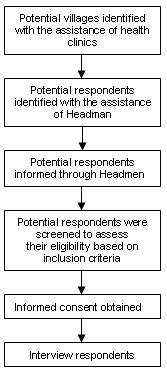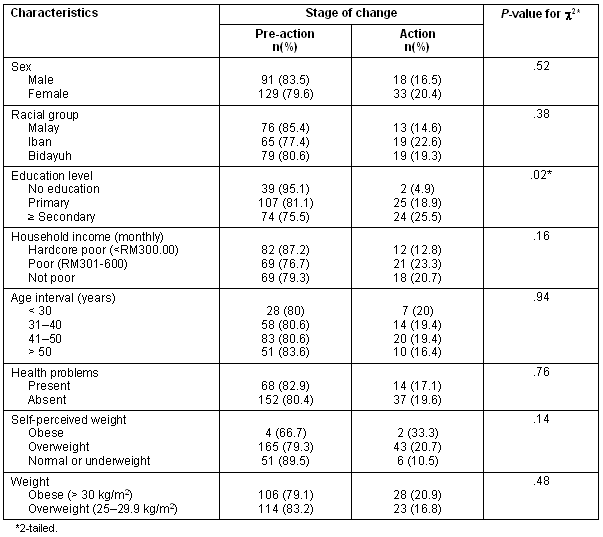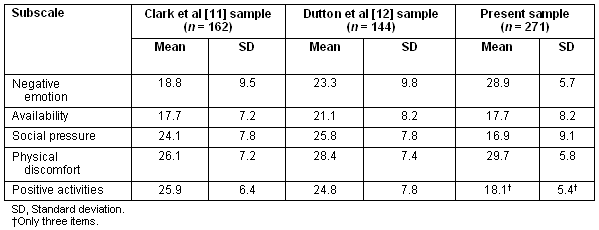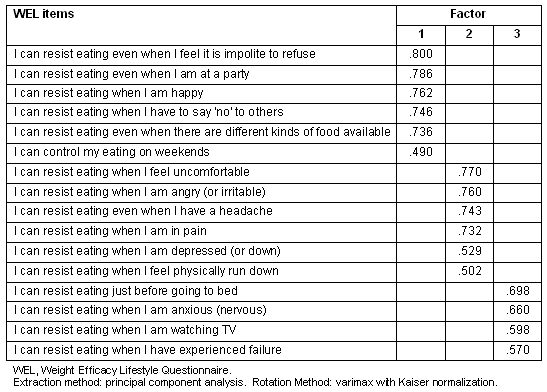full article:
Introduction
The problems of overweight and obesity have reached epidemic proportions in many developed countries1. In the USA, approximately 64.5% of adults are classified as overweight2. In Malaysia, approximately one in two adults aged 25 to 64 years were either overweight or obese, with the highest prevalence among Indians, followed by Malays and Chinese3. The Malaysian Health Minister noted in 2003 that Malaysia had 6 million adults who were either overweight or obese. He appealed for appropriate action because the prevalence of obesity and overweight climbed from 4.4% and 16.7% in 1996, to 12.3% and 26.7%, respectively, in 20034.
The 1996, the Malaysian National Morbidity Survey in Sarawak (n = 4739 adults) revealed that 3.4% were obese and 14.2% were overweight5. Another stratified cross-sectional study of 630 households with medium to low socio-economic level (n = 1379) in four major towns revealed that 12.3% of the adults were obese and 32.5% were overweight6. The respondents were drawn from five indigenous groups and one Chinese population. Among the overweight indigenous respondents (n = 339), the Iban had the largest percentage at 39.5% (n = 134), followed by the Malay at 38.9% (n = 132), Melanau at 11.6% (n = 8.7%), Bidayuh and other indigenous groups at 5% each (n = 17). Among the obese indigenous respondents (n = 145), the Malay group had the largest percentage at 46.9% (n = 68), Iban at 33.8% (n = 49), Melanau at 8.2% (n = 12), Bidayuh at 2.1% (n = 3), and other indigenous groups at 9% (n = 13). It is important to note that the Bidayuh only made up 5.3 % (n = 59) of the total indigenous sample (n = 1119). Because the Bidayuh are mostly rural dwellers, it is not surprising such a small sample was recruited.
Both studies5,6 showed that overweight and obesity is a problem in Sarawak. Kiyu and Hashim's6 study revealed that among the indigenous town dwellers, the Ibans and Malays had the largest percentage of overweight and obese respondents. There was no published study found regarding the prevalence among rural-dwelling natives of overweight and obesity (the National Morbidity Survey only reported the overall rate), thus this study aimed to fill the gap. For logistical reasons, it was decided that one geographic region would be used as the research site. Because the indigenous groups residing in this geographical region were predominantly Iban, Malay and Bidayuh, these three groups were studied. Although Kiyu and Hashim's6 study revealed a very low percentage of Bidayuh to be overweight or obese (from a town sample), the present author's experience suggested this was an underestimate.
Existing studies of overweight and obese adults in Sarawak5,6 were prevalence studies. To date, no published Malaysian study has examined overweight and obese adults in depth, for example their intention to lose weight, or their efficacy in controlling eating when feeling vulnerable.
Regarding individuals' intention to lose weight, the transtheoretical model of change (TTM) suggests how change occurs7. The TTM views change as a process with five progressive stages of change (SOC) before a change of behavior occurs. Many studies have demonstrated the applicability of SOC to weight loss2,8.
The five SOC stages7 commence with precontemplation, preceeding change by 6 months. Individuals in the precontemplation stage may be ignorant of the effects of their behavior, or unwilling to attempt change due to previous failed attempts. The second SOC stage is the contemplation stage, when an individual is considering change within the next 6 months due to awareness of a problem. The preparation stage is when an individual intends to take action in the next 30 days. Individuals in this stage may attempt to find out how to change a particular unhealthy behavior (eg overeating). In the action stage, there is overt modification of a behavior for less than 6 months. In the maintenance stage, individuals have taken action to change a behavior for more than 6 months.
Regarding weight loss efforts, it was decided that individuals at the action stage would consume less than 30% of their calories from fat, and also have to be vigilant for relapse. Individuals in the maintenance stage were expected to lose 5% or more of their baseline weight (based on a study of the benefits of 5% or more weight loss being sufficient to reduce the co-morbid risk factors of obesity, such as hyperlipidemia, hyperinsulinemia, hypertension and type 2 diabetes9. Studies have shown that determining individuals' intention to change facilitates the implementation of stage-matched interventions (crucial for the interventions to be effective)2.
Individuals' SOC may be affected by their confidence to cope with high-risk situations where they would relapse into unhealthy behavior10. Individuals' confidence in coping with high risk situations can be assessed using a self-efficacy scale. Self-efficacy, originally conceptualized by Bandura in his social learning theory, refers to how individuals perceive their confidence to perform a task in certain vulnerable situations10. A change in the level of self-efficacy as a result of gaining skills to perform certain behavioral change can predict lasting success11.
Concern about the increased prevalence of overweight and obesity among all Malaysian ethnic groups in both rural and urban communities12 prompted the Malaysian Association for the Study of Obesity, in collaboration with Malaysian Ministry of Health, to formulate the Guidelines for the Prevention of Obesity in Malaysia12. While guidelines are helpful, it can be argued that before overweight and obesity can be addressed effectively, it is important to understand individuals' motivation and intention to lose weight. This aspect of weight loss is largely unknown for individuals in Malaysia and Sarawak. Thus, the objective of the present study was to determine the:
- Distribution of SOC among overweight and obese rural indigenous adults
- Stage distribution for weight loss and its relationship with socio-demographic characteristics
- Level of self-efficacy of the respondents
- Factor structure of the self-efficacy scale applied to this sample.
Methods
This study was approved by the Ethics Committee of Faculty of Medicine and Health Sciences, Universiti Malaysia Sarawak, and conformed to the requirements for ethical procedures for research in Malaysia. Informed consent was also obtained from each respondent.
This cross-sectional study was conducted from February 2006 to March 2007. Twenty-six villages in Kuching and Samarahan Division were included in the study. Due to the lack of an enumerated list of overweight and obese adults, and a failure to recruit sufficient numbers of respondents by randomly selecting the villages, a purposive sampling method was employed. The process of respondent recruitment is summarized in the flow chart (Fig1).

Figure 1: Process of respondent recruitment.
The inclusion criteria for recruitment were: adults of both sex; racial origin of Malay, Iban or Bidayuh; aged between 21 and 65 years; a body mass index of between 25 and 29.9 (overweight) or ≥30 (obese); those with no obvious chronic health conditions who were intellectually capable. A sample size of at least 200 people was required to ensure correlation and factor analysis on one of the scales. A ratio of at least 10 subjects for each variable is desirable for factor analysis13,14.
A pre-tested structured questionnaire was used to collect the study data. The questionnaire assessed socio-demographic details, perception of body weight, and the presence of health problem/s. Two scales were used: (i) Weight: SOC15 to assess readiness for change; and (ii) Weight Efficacy Lifestyle Questionnaire (WEL)16 to assess respondents' confidence regarding their ability to resist eating in certain vulnerable situations. These scales were adapted using the TTM to form part of the data collection instrument.
The SOC questionnaire consisted of a 5 item algorithm to determine respondents' stage. The first item asked if respondents intended to lose weight in the next 6 months15. If the response was 'No', they were in the precontemplation stage. If they intended to lose weight in the next 6 months, they were in the contemplation stage. Respondents who reported that they were planning to lose weight in the next month were in the preparation stage. Respondents who had taken appropriate actions, such as reducing dietary fat, reducing portions and exercising, and had started to lose weight (less than 5% of the baseline weight) and had done so within the past 6 months were in the action stage. Respondents in the maintenance stage had lost more than 5% of their weight and had taken action for more than 6 months.
The WEL includes 20 items to be rated on a 10 point Likert scale ranging from 0 (not confident) to 9 (very confident)16. There are 5 subscales, each consisting of 4 items relating to negative emotions (eg eating when irritated); food availability (eg eating during a party); social pressure (eg eating when unable to refuse an invitation to eat); physical discomfort (eg eating when in pain or during a headache); and positive activities (eg eating when reading or watching television). The WEL yields 5 subscale scores and a global sum of the subscales. The internal consistency of the 5 subscales was found to be from .70 to .9016.
Respondents' anthropometric measurements were recorded, as well as an interview. It was necessary to conduct the interviews with structured questionnaires due the large percentage of rural dwellers who were illiterate. The interviews were conducted in the Malaysian national language, based on questionnaires (including the SOC and WEL questionnaires) that were translated from English into the Malaysian national language using the 'back translation' technique. Most of the interviews were conducted in the village community hall, with a small percentage in respondents' homes.
Data analysis
The Statistical Package for Social Science v14 (SPSS Inc; Chicago, IL, USA) was used for analysis. Chi-squared tests were used to compare SOC by patient characteristics; p-values of <0.05 were considered statistically significant. Principal component analysis was used for factor analysis of the WEL scale.
Results
Respondent characteristics
A total of 271 respondents (male = 109, female = 162) participated. There were 32.8% (n = 89) Malays; 31% (n = 84) Ibans; and 36.2% (n = 98) Bidayuhs, ranging in age from 21 to 65 years (mean age = 42.5 years). Approximately 15% (n = 41) of the respondents had no schooling, 48.7% (n = 132) had a primary level of education while the remainder 36.2% (n=98) had a secondary or higher level of schooling. In all, 11.1% (n = 30) were not employed; 29.9% (n = 81) did not have family members who were overweight or obese; 59.8% (n = 162) had siblings and the remainder had either one or both parents with obesity. While 30.3% (n = 82) reported having health problems, the majority perceived themselves to be healthy. Only 2.2% (6) perceived themselves to be obese, 76.8% (n = 208) perceived that they were overweight, while the remainder perceived themselves to be either thin or of normal weight. Other aspects of the socio-demographic profile are reported (Table 1).
Table 1: Respondent characteristics

Stage of change for weight loss
Stage distribution for weight loss showed that 60.5% (n = 164) of the respondents were in the precontemplation stage; 20.7% (n = 56) in the contemplation stage; 8.5% (n = 23) in the preparation stage; 8.9% (n = 24) in the action stage; while only 1.5% (n = 4) were in the maintenance stage. The SOC data were analysed by respondents characteristics (Table 2). Because there were fewer respondents in the preparation, action and maintenance stages, the respondents were then subdivided into only 2 groups, pre-action group (precontemplation and contemplation), and action group (preparation, action and maintenance).
The stage of change differences were generally stable regarding age, sex, race, household income, presence or absence of health problem, self perceived weight and whether respondents were overweight or obese. Education affected the stage distribution with the proportion of respondents in the pre-action stage decreasing as education level increased (χ2
Table 2: Association of respondent characteristics with stages of change

Scale properties and factor analysis
When analysing the WEL global and subscale scores, the item 'I can resist eating when I am reading' was excluded because approximately 30% of the respondents claimed that they never read. Based on Dutton and colleagues' approach to validating the WEL scale, the WEL subscale scores of the present study were compared with the scores obtained in Clark and colleagues' study16 and Dutton and colleagues' study11 (Table 3). The present sample scored lowest in the social pressure subscale, highest in the negative emotion subscale, and was comparable in other the subscales, except for positive activities (due to 3 items only) of the other two studies.
Table 3: Comparison of the present baseline Weight Efficacy Lifestyle questionnaire subscale scores with two other studies

The internal consistency of the WEL subscales was assessed for this sample. Cronbach's coefficients were .47 for positive activities, .60 for negative emotions, .77 for physical discomfort, .78 for availability and .86 for social pressure. These findings were lower than those obtained by Clark and colleagues16, who found coefficients ranging from .70 to .90, and those obtained by Dutton and colleagues, where Cronbach's coefficient ranged from .69 to .84.
An exploratory factor analysis was then performed to validate the factor structure of the WEL for this study sample. A principal component analysis with Varimax rotation was performed and factors with eigenvalues of greater than 117, and items with loadings of .4017 or more were retained. When 19 items of the WEL were included in the initial analysis, the determinant value was 0, indicating at least one linear dependency in the matrix14. Pett and colleagues14 advocate removing items that have a high correlation with each other from the analysis. Subsequently 3 items were excluded from the analysis, which included: 'I can resist eating even when others are pressuring me to eat' (r = .713), 'I can resist eating even when high-calorie foods are available' (r = .659) and 'I can resist eating even when I think others will be upset if I don't eat'(r = .638). The 16 items were then analyzed and the determinant value was 0.04.
To assess the strength of the linear association among items in the correlation matrix, Bartlett's test of sphericity and Kaiser-Meyer-Olkin (KMO) measure of sampling adequacy should be examined14. Bartlett's test of sphericity in this study was significant (χ2 = 1447.351, p = .000), which indicated that the correlation matrix was not an identity matrix. The KMO statistic (.86), met Kaiser's18 'meritorious' criteria. The item-to-total scales correlation ranged from .793 to .921. The KMO value and Bartlett's test of sphericity formed the basis for further factor analysis. Cronbach's α for the total 16 item scale was .85.
Table 4 show the total variance explained by three extracted factors of WEL for this study sample, and the model accounted for 53.8% of the variance (Table 4). Six items were loaded on factor 1 and six items on factor 2, and four items were loaded on factor 3 in the final solution (Table 5).
Table 4: Total variance explained by the three extracted factors of the Weight Efficacy Lifestyle Questionnaire scale

Table 5: Factor loadings from the rotated factor structure matrix for the Weight Efficacy Lifestyle Questionnaire scale (rotation converged in 4 iterations)

In reliability analysis test for factor 1, Cronbach's α coefficient was .83, the inter-item correlation ranged from .26 to .63 with the mean inter-item correlation of .46, and a variance of .0096. For factor 2, the Cronbach's α coefficient was .82, the inter-item correlation ranged from .21 to .48 with the mean inter-item correlation of .42, and a variance of .0082. The Cronbach's α coefficient for factor 3 was .63, the inter-item correlation ranged from .21 to .40 with the mean inter-item correlation of .30, and a variance of .0039. All interitem correlations of the three factors were less than .80, suggesting that none of the items were duplicates14. There were also no negative correlations within items. These findings showed that interpretation of the reliability analyses was possible14. The variance values of nearing 0 for all factors indicated that there was high consistency among the interitem correlations14.
Discussion
Although the Malaysian Ministry of Health has implemented a range of health promotion activities targeting the increased prevalence of overweight and obesity19, success is yet to be seen12. As obesity is a cormorbid risk factor for many cardiovascular diseases, diabetes mellitus and certain types of cancer1, this lifestyle problem must be further researched. Most of the Malaysian studies were epidemiological, focused on assessment of the prevalence of obesity and overweight3,5,6. No previous published research has examined the SOC among or used the WEL for overweight and obese individuals in Malaysia and Sarawak. Assessment of SOC provides information about the proportion of population that is ready for change. This information is imperative in order to develop stage-matched strategies to overcome a problem2. For example, for those people identified as being in the preparation or action stages, strategies that impart skill and techniques to enhance behavioral change may be most effective. Similarly, individuals in the precontemplation and contemplation stages need strategies to motivate them to change, rather than other unmatched SOC approaches2.
This study showed that over 80% of the respondents had not taken action to lose weight (65% precontemplation; 20.7% contemplation) although 76.8% perceived themselves to be either overweight or obese. The proportion of respondents in the precontemplation SOC in this study was higher than other studies (eg Larforge and colleagues2, (45%); Hawkinand colleagues15, 49%). When the respondents were randomly interviewed to discover their reason/s for not taking action to lose weight, many claimed they did not know how to do so. Some respondents reported drinking sour cordial juice which they admitted was ineffective. One woman said, 'I drink lime juice, lime water, twice a day. But my body weight still maintains. Not increase, not decrease, maintain only'.
Povey and collegues20 claimed that SOC might wrongly classify individuals into the action or maintenance stages of change in a self-administered questionnaire, especially if the respondents wrongly perceived they had made a healthy change. In order to avoid over-representation of people in the action stage of change, respondents who claimed that they had 'taken action' such as applying 'sliming cream', used a corset or drank 'sliming tea' for extended periods of time without any effect were classified into the preparation stage of the present study. Approximately 5% of women were in this category.
Except for educational level, the stage differences were generally stable regarding age, sex, race, household income, presence or absence of health problem, self-perceived weight and whether they were overweight or obese. Education appears to have an impact on overweight and obese individuals' SOC, probably reflecting that a better understanding of the ill-effects of being overweight or obese motivates action to modify behavior. That there were no significant differences between other demographic characteristics and SOC suggests that similar stage-matched strategies might be suitable for this sample. The high proportion of respondents in the pre-action stage may explain why the Malaysian Ministry of Health's ready-for-action strategies (eg health campaigns on 'healthy eating', 'exercise' and 'healthy lifestyle') failed to curb the increased incidence of overweight and obesity4.
For self-efficacy in eating control, when compared with the original WEL validation sample11,14 (Table 3) the current study sample seemed less able to resist eating with social pressure. This finding is not surprising because social eating is a norm among Sarawak indigenous people, and refusing to join others in eating may be considered rude behavior. This study sample had a higher level of self-efficacy in situations when they experienced negative emotions, compared with African-American females11 and predominantly Caucasian samples14. They were also able to resist eating when experiencing physical discomfort. These findings showed that the current sample did not use eating to ease their physical and emotional problems.
The findings of the factor analysis resulted in a 16 item, three-factor solution, rather than the 5 factors reported by Clark and colleagues14. None of Clark and colleagues' 5 original factors were retained unchanged in the current exploratory factor analysis. In the current study, 2 items from the social pressure subscale, 3 items from the availability subscale and one item from positive activities were loaded on to factor 1 (Table 5). The combination of items from different subscales is still considered appropriate if one considers that 'a second helping' may indicate food availability in low-income group12 and 'having to say 'no' to others' may also mean that food is available, thus one is invited to share the food. The item 'eat when happy' may also link to the availability of food, otherwise one would engage in other activities rather than eating when one is happy. A Cronbach's α of .83 demonstrates that 83% of the variance of the total scores on this subscale can be attributed to reliable variance, and a variance value of .0096 indicates that there is consistency in the inter-item correlation14.
The original 4 items in Clark and colleagues'14 physical discomforts were retained in the second factor of this study. In addition, two other items from negative emotions, 'eat when angry', and 'eat and depressed' were also loaded on to the same factor. An examination of the Cronbach's α (.82) of this factor shows internal consistency, and a variance of .0082 supports the consistency of the inter-item correlation. However, discrimination between physical discomfort and negative emotions is less clear. Because negative emotions and physical discomfort affect individuals psychologically, it makes sense to load these items on to the same factor.
Factor 3 of this study is a combination of 2 items for the original positive activities subscale ([5] I can resist eating when I am watching TV; and [15] I can resist eating just before going to bed), and 2 items from the negative emotions subscale ([1] I can resist eating when I am nervous; and [16] I can resist eating when I experienced failure). Cronbach's α was .63, which is considered questionable13. The inter-item correlation was low (range .21 to .40) and the variance of .0039 showed consistency of low inter-item correlations, reflecting that the items were relatively heterogenous. This suggests that this component is less salient as a subscale to differentiate positive activities and negative emotion for this sample.
Although 4 items of the original scale ([10] I can resist eating when I am reading; [13] I can resist eating even when others are pressuring me to eat; [17] I can resist eating even when high-calorie foods are available; and [18] I can resist eating even when I think others will be upset if I don't eat) were removed, these items are important and should be included in future studies in Malaysia. The high correlation coefficient of 3 items ('eat when pressured by others', 'eat when high-calorie foods are available' and 'eat to avoid upsetting people') may 'occur when one person's answers are the exact replica or are a linear combination of another person's answer'14, p 67, but may not recur in another sample. The reason for dropping 'eat when reading' was due to approximately 30% of the respondents reporting that they did not read. Not reading is common in a sample of individuals who are not educated or who have little education.
Limitations
This study has potential limitations due to the sampling and data collection methods. The purposive sample used may limit generalizability of the findings. However, this study has yielded the important insight that a large portion of overweight or obese adults were not contemplating to lose weight. The study also identified the importance of assessing individuals' SOC before implementing strategies for modifying behavior. Although self-reported data may be contaminated by self-presentation bias, in this case inflating the percentage of respondents in the action SOC, the findings suggested the opposite. However, if face-to-face interviews had been used to collect data, respondents' actual SOC could have been ascertained, using such additional questions as, 'How did you do it?' and 'Have you lost any weight'.
Conclusion
The current study demonstrated that a high proportion of respondents who were not ready to lose weight required appropriate strategies to motivate them to change. It also reflected the need to assess individuals' SOC before implementing treatment strategies. Also apparent was that the factor structure of the two WEL subscales was only partially able to differentiate between availability and physical discomfort in this sample. The respondents appeared less able to resist eating when foods were available (eg when invited to eat or happy). Any situation that affected the respondents psychologically would affect their urge to eat, indicating that they did not eat for comfort. Combining items in factor 3 and dropping 4 items from the WEL scale, suggested differences in the correlations of eating self-efficacy in this sample from those hypothesized among Caucasian and African-American women. Further studies are recommended to examine SOC and WEL among different groups, for example in those of higher income and better education. Further factor analysis studies are also required to validate the WEL, especially in the Malaysian population.
Acknowledgements
The author is grateful to all the respondents of this study. Gratitude is also expressed to Associate Professor Dr Hong Kiam Sam, Universiti Malaysia Sarawak (UNIMAS) for reading and commenting on the initial draft.
References
1. World Health Organization. Obesity and overweight. Fact sheet no 311. (Online) 2006. Available: http://www.who.int (Accessed 16 July 2007).
2. Laforge RG, Velicer WF, Richmond RL, Owen N. Stage distributions of five health behaviors in the United States and Australia. Preventive Medicine 1999; 28: 61-74.
3. Malaysian Ministry of Health. Malaysian NCD Surveillance 2005/2006. (Online) 2007. Available: http://www.dph.gov.my/ncd/surveillance/index.php (Accessed 16 July 2007).
4. Chua SL. Speech for the official opening of 2nd Asia Pacific Obesity Conclave/MASO 2007. (Online) 2007. Available: www.moh.gov.my (Accessed 1 September 2007).
5. Malaysian Ministry of Health. National Health and Morbidity Survey Report. Kuala Lumpur: Malaysian Ministry of Health, 1996.
6. Kiyu A, Hashim J.
7. Prochaska JO, DiClemente CC. Stages of change in the modification of problem behavior. Progress in Behavior Modification 1992; 28: 184-214.
8. Sarkin JA, Johnson SS, Prochaska JO, Prochaska JM. Applying the transtheoretical model to regular moderate exercise in an overweight population: validation of stages of change measure. Prevention Medicine 2001; 33: 462-469.
9. Van Gaal LF, Wauters M, De Leeuw ICH. The beneficial effects of modest weight loss on cardiovascular factors. International Journal of Obesity 1997; 21(Suppl 1): S5-S9.
10. Bandura A. Self-efficacy: toward a unifying theory of behavior change. Psychological Review 1997; 84: 191-215.
11. Dutton GR, Martin PD, Rhode PC, Brantley PJ. Use of the weight efficacy lifestyle questionnaire with African American women: validation and extension of previous findings. Eating Behaviors 2004; 5: 375-384.
12. Technical Committee on Guideline for the Prevention of Obesity. Guidelines for the prevention of obesity in Malaysia. Kuala Lumpur: Malaysian Association for Obesity Study, 2004.
13. Dixon JK. Grouping techniques. In: Munro BH (Ed.). Statistical methods for health care research, 3rd edn. Philadelphia: Lippincott, 1997; 310-341.
14. Pett MA, Lackey NR, Sullivan JJ. Designing and testing the instrument. In: MA Pett, NR Lackey, JJ Sullivan (Eds). Making sense of factor analysis: the use of factor analysis for instrument development in health care research. Thousand Oaks: Sage, 2003; 10-50.
15. Hawkins DS, Hornsby PP, Schorling JB. Stages of changes and weight loss among rural Africian Amercian women. Obesity Research 2001; 9: 59-67.
16. Clark MM, Abrams DB, Niaura RS, Etton CA, Rossi JS. Self-efficacy in weight management. Journal of Consulting and Clinical Psychology 1991; 59: 739-744.
17. Kaiser HF. The application of electronic computers to factor analysis. Educational and Psychology Measurement 1960; 20: 141-151.
18. Kaiser HF. An index of factorial simplicity. Psychometrika 1974; 39: 32-36.
19. Public Health Department. "Sihat, Cergas, Ceria". Malaysia Ministry of Health. Available: http://dph.gov.my/ncd/scc/index.htm (Accessed 17December 2004).
20. Povey R, Conner M, Sparks P, James R, Shepherd R. A critical examination of the application of the transtheoretical model stages of change to dietary behaviours. Health Education Research 1999; 14: 641-651.
21. George D, Mallery, P. Reliability analysis. In: D George, P Mallery (Eds). SPSS for Windows, step by step: a simple guide and reference, 14th edn. Boston: Allyn & Bacon, 2003; 222-232.
